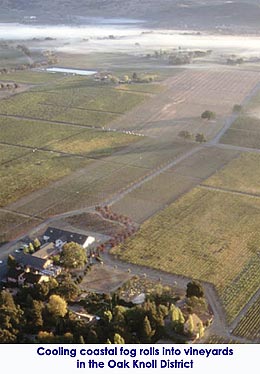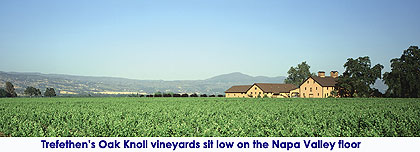
Oak Knoll District of Napa Valley (AVA)
Oak Knoll District to become the Valley’s 14th sub-appellation April 26
"An AVA will help us focus on distinctions and it will be an ongoing process for generations to come."
~ Janet Trefethen
by
Alan Goldfarb
March 19, 2004
Janet Trefethen’s birthday is coming early this year. It’s always been in November, but it may as well be April 26.
That’s the day that Oak Knoll will become the Valley’s 14th official sub-appellation, culminating in an odyssey that Trefethen helped shepherd beginning 10 long years ago.
“It was 10 years in terms of talking, having meetings, and opening a bank account,” said Trefethen of Trefethen Vineyards. “We wanted to get everything organized with neighbors, growers and vintners, to make sure they liked the (boundary lines).”
Well, not all parties -- as one can imagine with matters such as these -- liked what Trefethen and others were proposing. Not least of which was Oak Knoll Winery in Oregon, for obvious reasons.
But after labyrinthine talks and paper work which worked its way through the then ATF and now the TTB, the Pacific Northwest winery apparently was salved that Napa’s Oak Knoll wouldn’t be construed for Oregon’s.
However, Napa’s Oak Knoll will be saddled with the rather unwieldy rubric of Oak Knoll District of Napa Valley.
It’s something however that Trefethen thinks is a positive.
“I’m happy it’s Oak Knoll District of Napa Valley,” Trefethen said. “Consumers will understand it’s a geographic reference and is distinguished from Oak Knoll in Oregon, which is a brand name.”
So, why is it important to have an American Viticultural Area (AVA), and what makes them distinctive from the others?
“It (Oak Knoll) has distinguishing characteristics,” said Trefethen. “We’re very fortunate that we can grow both red and white wines. An AVA will help us focus on distinctions and it will be an ongoing process for generations to come.”
Because OKDNV is spanking new, Trefethen cautions that she and others in the district pretend not to know everything there is to know about their AVA. Why, just last week, anticipating its imminent approval, the region’s members and prospective affiliates held a meeting to ascertain among other things, how many more growers and vintners want to be counted; and how many wineries and brands actually source their fruit from the area.
“At the meeting last week we learned a lot,” she explained. “I didn’t realize that Opus (One) and (Joseph) Phelps sourced some of the fruit for their cab (from here). I learned of a lot more wineries that source fruit from here (43 at last count).
Before that meeting, there were already 16 bonded wineries within the OKDNV boundaries. Inside those boundaries are 8,300 acres, of which 3,500 are planted to 14 varieties predominated by Merlot, Chardonnay and Cabernet Sauvignon.
 The AVA is bisected by Highway 29 and bordered on the west by Dry Creek Road where it meets the Mt. Veeder AVA. To the north, the boundary line is at Ragatz Lane which heads east, while a contour line heading west begins about one-fifth of a mile south. The line then heads southeast along Dry Creek to the Silverado Trial and then goes south to Monticello Road and around to Milliken Creek and then stretches east along its southern boundary to Trancas and then to Redwood Road.
The AVA is bisected by Highway 29 and bordered on the west by Dry Creek Road where it meets the Mt. Veeder AVA. To the north, the boundary line is at Ragatz Lane which heads east, while a contour line heading west begins about one-fifth of a mile south. The line then heads southeast along Dry Creek to the Silverado Trial and then goes south to Monticello Road and around to Milliken Creek and then stretches east along its southern boundary to Trancas and then to Redwood Road.
So, what are the distinguishing taste characteristics that will define an Oak Knoll wine from those of the other 13 appellations?
“We don’t know everything now,” Trefethen admitted. “It’s an area of distinction that will ultimately help the consumer once we figure out what are the differences. I think I’d rather wait to define them (than to name them now).”
However, Trefethen pointed out that a group of sommeliers upon a visit a year ago determined that there were indeed distinctions in Oak Knoll.
“We were all flying from the seat of our pants because we’d not gotten together and tasted the (region’s wines) with anyone else (outside the area),” she said.
“But, they thought there was a definite thread that tied them together. They were more similar (to each other) and had more of a common basis (than wines from other AVAs). Not that they were better than, but it was different; a positive thing. There was reason for the designation. They (OKDNV wines) seemed to have more fruit structure, rather than great big tannins.”
With that, Trefethen headed to a luncheon appointment; and no doubt to make birthday plans to celebrate for herself and OKDNV.
That’s the day that Oak Knoll will become the Valley’s 14th official sub-appellation, culminating in an odyssey that Trefethen helped shepherd beginning 10 long years ago.

“It was 10 years in terms of talking, having meetings, and opening a bank account,” said Trefethen of Trefethen Vineyards. “We wanted to get everything organized with neighbors, growers and vintners, to make sure they liked the (boundary lines).”
Well, not all parties -- as one can imagine with matters such as these -- liked what Trefethen and others were proposing. Not least of which was Oak Knoll Winery in Oregon, for obvious reasons.
But after labyrinthine talks and paper work which worked its way through the then ATF and now the TTB, the Pacific Northwest winery apparently was salved that Napa’s Oak Knoll wouldn’t be construed for Oregon’s.
However, Napa’s Oak Knoll will be saddled with the rather unwieldy rubric of Oak Knoll District of Napa Valley.
It’s something however that Trefethen thinks is a positive.
“I’m happy it’s Oak Knoll District of Napa Valley,” Trefethen said. “Consumers will understand it’s a geographic reference and is distinguished from Oak Knoll in Oregon, which is a brand name.”

So, why is it important to have an American Viticultural Area (AVA), and what makes them distinctive from the others?
“It (Oak Knoll) has distinguishing characteristics,” said Trefethen. “We’re very fortunate that we can grow both red and white wines. An AVA will help us focus on distinctions and it will be an ongoing process for generations to come.”
Because OKDNV is spanking new, Trefethen cautions that she and others in the district pretend not to know everything there is to know about their AVA. Why, just last week, anticipating its imminent approval, the region’s members and prospective affiliates held a meeting to ascertain among other things, how many more growers and vintners want to be counted; and how many wineries and brands actually source their fruit from the area.
“At the meeting last week we learned a lot,” she explained. “I didn’t realize that Opus (One) and (Joseph) Phelps sourced some of the fruit for their cab (from here). I learned of a lot more wineries that source fruit from here (43 at last count).
Before that meeting, there were already 16 bonded wineries within the OKDNV boundaries. Inside those boundaries are 8,300 acres, of which 3,500 are planted to 14 varieties predominated by Merlot, Chardonnay and Cabernet Sauvignon.
 The AVA is bisected by Highway 29 and bordered on the west by Dry Creek Road where it meets the Mt. Veeder AVA. To the north, the boundary line is at Ragatz Lane which heads east, while a contour line heading west begins about one-fifth of a mile south. The line then heads southeast along Dry Creek to the Silverado Trial and then goes south to Monticello Road and around to Milliken Creek and then stretches east along its southern boundary to Trancas and then to Redwood Road.
The AVA is bisected by Highway 29 and bordered on the west by Dry Creek Road where it meets the Mt. Veeder AVA. To the north, the boundary line is at Ragatz Lane which heads east, while a contour line heading west begins about one-fifth of a mile south. The line then heads southeast along Dry Creek to the Silverado Trial and then goes south to Monticello Road and around to Milliken Creek and then stretches east along its southern boundary to Trancas and then to Redwood Road.
So, what are the distinguishing taste characteristics that will define an Oak Knoll wine from those of the other 13 appellations?
“We don’t know everything now,” Trefethen admitted. “It’s an area of distinction that will ultimately help the consumer once we figure out what are the differences. I think I’d rather wait to define them (than to name them now).”
However, Trefethen pointed out that a group of sommeliers upon a visit a year ago determined that there were indeed distinctions in Oak Knoll.
“We were all flying from the seat of our pants because we’d not gotten together and tasted the (region’s wines) with anyone else (outside the area),” she said.
“But, they thought there was a definite thread that tied them together. They were more similar (to each other) and had more of a common basis (than wines from other AVAs). Not that they were better than, but it was different; a positive thing. There was reason for the designation. They (OKDNV wines) seemed to have more fruit structure, rather than great big tannins.”
With that, Trefethen headed to a luncheon appointment; and no doubt to make birthday plans to celebrate for herself and OKDNV.













